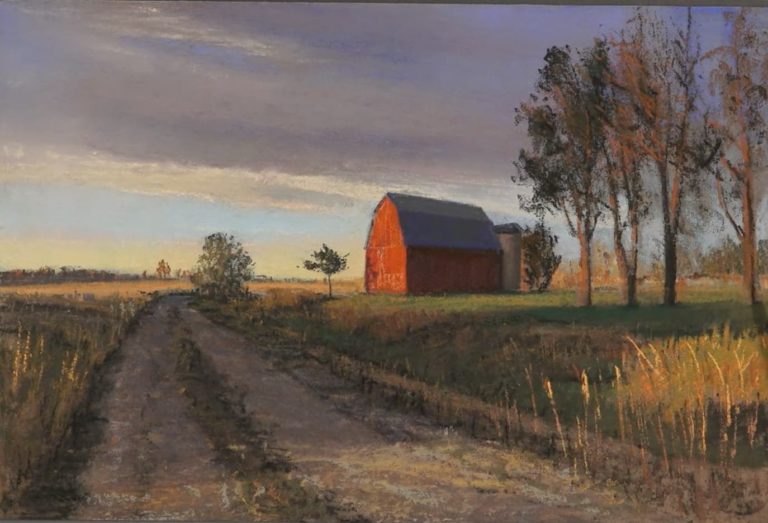Every now and then it’s important to take yourself back to school and focus on elevating your core techniques. We all know the art fundamentals of color theory, color mixing and perspective are the building blocks to great painting, so taking the time to kick those skills up a notch is always worth it.
Read our chat with artist Scott Maier, Executive Director of Video for Artists Network, and the instructor for our new interactive courses on Perspective Drawing, Color Mixing and Color Theory. With these courses you get personalized video feedback on your paintings directly from Scott. Here he discusses the importance of gaining a deeper understanding of the fundamentals, how to embrace the “practice” of painting and drawing over the perfection, and why breaking your own habits is the key to success.
What is your art background?
Scott Maier: I’ve been painting for nearly 25 years, beginning when I got my BFA in painting at the Maryland Institute College of Art in Baltimore and my MFA from the University of Alaska Fairbanks. Since then, I’ve continued to paint (plein air landscapes, mostly) while spending over 15 years teaching Painting, Drawing, Art Appreciation, Color Theory, and Design Fundamentals at various colleges and universities. I also taught art courses online where I gained an appreciation for the tools that digital technology provide artists.
Why is it so important to master the fundamentals of color mixing, perspective and color theory?
Art fundamentals aren’t skills you learn and move beyond. Mastering the fundamentals is something that is ultimately never achieved. It’s about being on the path towards mastery, not becoming a master. It’s about developing an ever-deepening understanding and appreciation for line, shape, color, form, texture, etc.
What is the most common challenge artists face in mastering these fundamentals? How will your courses help address those challenges?
When beginning to learn these fundamentals, the biggest challenge students face is their own patience. My experience in teaching adults is that they can be unkind and impatient with themselves. Fundamental classes like Color Theory, Perspective, and Color Mixing require students to challenge their perceptions, which can feel uncomfortable first. My course exercises are designed to help students embrace the “practice” of painting and drawing, not the perfection. They are intended to help students develop healthy mindsets, so they can gain their own understanding of the concepts.
For the folks that have never taken an interactive course, can you explain the type of video feedback you will provide?
In all the feedback, I strive to point out what is working well and what could use additional attention. I try to give high quality feedback that students can use to evaluate their own work moving forward. In each painting, it’s important to observe the strengths and weaknesses. This allows artists to move into the next painting with intention, focusing on repeating strengths and strengthening weaknesses.
How do you continue to master these art fundamentals in your own work and what challenges have you faced?
The biggest challenge I’ve faced is breaking my own habits. It’s easy to fall into a pattern of painting, ultimately creating a rut that’s difficult to get out of. As much as I can, I approach each painting as an entirely new experience, changing my pigments and materials every few months. It’s satisfying to use the materials I’m comfortable with in a process that leads to predictable results. But it’s an even greater feeling when I’ve had a successful painting experience that’s kept me on my toes. I often come away with a new or deeper understanding of the fundamentals.
For example, replacing Cobalt Blue with Phthalo allowed me to see “blue” in the landscape in a whole new way. And positively transformed my painting process. It was challenging working with the intensity of Phthalo, but it led to a greater appreciation for color and the landscape.
What advice do you have for artists struggling with mastering color and perspective?
First, get comfortable “wasting” materials. If you’re struggling with color, use paint. A lot of it. If you’ve mixed a color and you know it’s not right, keep working on it until it is. Wasted paint is a necessary sacrifice for better painting. If you’re struggling with perspective, draw a lot. More precisely, sketch a lot. Much of what’s needed to understand perspective can be accomplished in a quick sketch rather than a fully rendered drawing. Making 100 sketches in 1 hour is more beneficial than one finished drawing in the same amount of time.
Second, think of painting and drawing as verbs, not nouns. Your finished paintings and drawings are records of the experiences you had making them. If you’re not enjoying the process, it will show in the finished product. If you love the process, you will make more art and get farther along the path towards mastery.
The interactive streaming courses with Scott Maier, Perspective Drawing, Color Mixing and Color Theory run Jan 11-Jan 24, 2020. During that time, Scott will provide assignments and send video-recorded feedback to each student. After the course dates, viewers will continue to have access to the recorded videos, discussion boards, and gallery, where you can share work and ideas with other students in the community.
